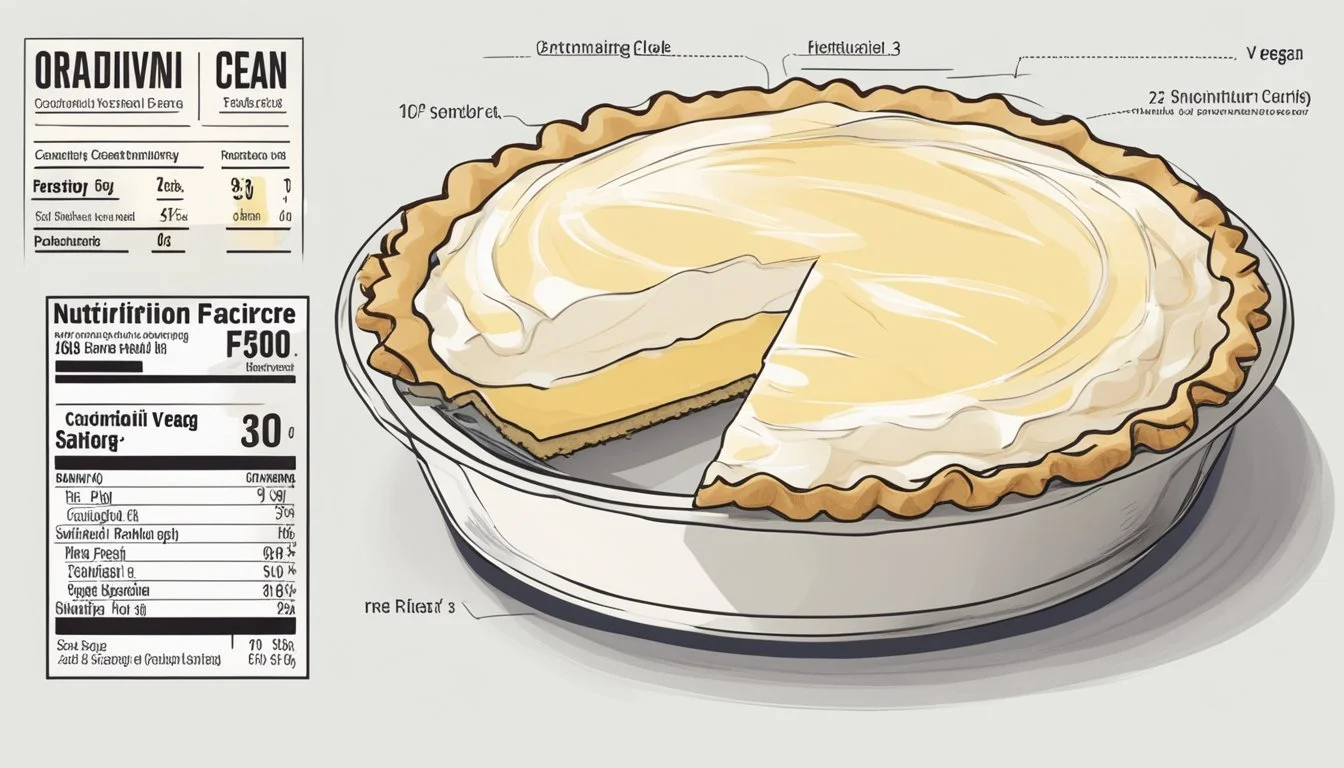Is Coconut Cream Pie Vegan?
Unveiling the Dessert's Dietary Profile
Coconut cream pie is a beloved dessert with a rich, creamy texture that many enjoy. Traditional recipes rely on ingredients like eggs, butter, and milk, making them unsuitable for those following a vegan lifestyle. However, with the rising popularity of plant-based diets, there is an increasing demand for vegan versions of classic desserts (What wine goes well with desserts?), including coconut cream pie.
To create a vegan coconut cream pie, bakers make several substitutions to ensure that every component of the dessert aligns with vegan standards. Plant-based milk and cornstarch can replace the traditional custard base, and coconut milk provides the characteristic creaminess without the need for animal-derived products. When it comes to the crust, a mixture of oats, almonds, and shredded coconut often replaces the classic buttery pastry.
The incorporation of ingredients like vegan butter and organic powdered sugar makes it possible to achieve an indulgent flavor while adhering to vegan guidelines. These ingredients, combined thoughtfully, produce a coconut cream pie that is both vegan and satisfying, ensuring that the dessert can be enjoyed by a wider audience without compromising on taste.
Understanding Veganism
In the context of food, veganism entails the exclusion of all animal products and by-products to embrace a plant-based diet. This principle specifically involves choosing ingredients that are neither derived from animals nor involve animals in their production processes.
Defining Vegan Products
A vegan product is one that contains no animal-derived ingredients. This means that every component of the product, from the base ingredients to the additives, must be plant-based or synthetic as long as it's not sourced from an animal. Vegan items are inherently dairy-free and egg-free, since dairy and eggs are animal products.
To classify a food item as vegan, one must ensure that:
All ingredients are plant-based or synthetic.
Processing aids or additives do not come from animal sources.
Common Non-Vegan Ingredients in Desserts
When assessing desserts for vegan compliance, certain ingredients commonly sourced from animals are red flags. These non-vegan components primarily include:
Dairy products: such as milk, butter, and cream, which are derived from animals.
Eggs: often used as binders or leavening agents in baking.
Gelatin: a thickening agent sourced from animal collagen.
Honey: a sweetener produced by bees
Identifying non-vegan ingredients requires a careful reading of labels and knowledge of ingredient origins, as some may not be as obviously animal-derived.
Components of Coconut Cream Pie
A traditional coconut cream pie consists of three main components: a crust that provides a firm base, a creamy filling rich with coconut flavor, and a light whipped topping, often garnished with toasted coconut flakes.
Crust
The crust serves as the foundation of the pie. It's typically made from a combination of graham cracker crumbs or pastry flour with a binding agent, such as butter or oil, for structural integrity. For a vegan coconut cream pie, alternatives like oats, ground almonds, or shredded coconut, combined with a plant-based substitute for butter, create a firm base without the use of animal products.
Filling
The filling is the heart of the coconut cream pie. It generally requires coconut milk and coconut cream for a robust coconut taste. The richness is achieved by cooking these ingredients with sugar for sweetness and cornstarch as a thickener. To enhance the flavor, vanilla extract is added. Ensuring that the coconut cream and milk are unsweetened and full-fat will deliver the desired creamy texture and depth of flavor.
Topping
Completing the pie is the topping, fashioned out of whipped coconut cream that's beaten until light and fluffy, sometimes sweetened with a touch of sugar. The use of coconut cream ensures that the topping is vegan, as it replaces the dairy-based whipped cream traditionally used. A chilled can of coconut cream, once whipped, provides the perfect airy consistency to contrast the dense filling.
Veganizing Coconut Cream Pie
Transforming a classic coconut cream pie into a delicious vegan version involves substituting non-vegan components such as butter, eggs, and dairy with plant-based alternatives. These swaps are simple yet effective in recreating a vegan coconut cream pie that rivals traditional recipes.
Vegan Pie Crust Options
The base of any pie, the crust, often contains butter and occasionally lard, which are not suitable for a vegan diet. However, one can easily create a vegan pie crust with the following substitutes:
Butter: Use cold coconut oil or vegan margarine as a direct substitute for butter.
Lard: Swap lard for shortening (ensure it's labeled vegan as some brands contain animal fats).
For a healthy crust, one might choose to use ingredients like rolled oats and almonds combined in a food processor until a fine meal forms.
Vegan Coconut Cream Filling
A classic coconut cream filling typically includes eggs and dairy milk, but replacing these ingredients is straightforward:
Milk: Utilize plant-based milks such as almond, soy, or coconut milk.
Eggs: Thicken the filling with cornstarch or agar agar instead of eggs to achieve the desired consistency without the use of animal products.
Ingredients such as shredded coconut, sugar (make sure it's not processed with bone char), and vanilla extract contribute to the rich flavor and texture of a dairy-free coconut cream pie.
Vegan Whipped Topping Alternatives
The finishing touch to any coconut cream pie is the whipped topping. For a vegan whipped cream, options include:
Coconut cream: Chill a can of full-fat coconut milk and whip the solidified cream.
Store-bought vegan whipped creams: Ready-to-use products that are convenient and egg-free.
To sweeten, one could use organic powdered sugar, ensuring it's vegan-friendly. Chill the whipped cream before topping the pie to maintain its structure.
Vegan Coconut Cream Pie Recipe
Creating a vegan coconut cream pie is quite straightforward and involves using plant-based substitutes in place of traditional dairy ingredients. This dessert can easily satisfy the sweet tooth of both vegans and non-vegans alike.
Ingredients
Filling:
Plant milk: 1 1/2 cups (e.g., almond, soy, oat)
Organic sugar: 1/3 cup
Cornstarch: 1/4 cup
Full-fat coconut milk: 1 can (13.5 ounces)
Vegan butter: 2 tablespoons
Vanilla extract: 1 teaspoon
Sweetened shredded coconut: 1 cup
Crust:
Gluten-free pie crust: 1 (can be pre-made)
Whipped Topping:
Coconut cream: 1 can (chilled overnight)
Powdered sugar: to taste
Instructions
Prepare the Filling:
In a bowl, mix the plant milk with cornstarch until smooth.
In a saucepan, combine the plant milk mixture, coconut milk, and organic sugar.
Cook over medium heat, whisking constantly, until the mixture thickens.
Remove from heat, add vegan butter and vanilla extract, stirring until incorporated.
Fold in the sweetened coconut. Pour the filling into the pie crust and chill until set.
Prepare the Whipped Topping:
Scoop out the solid part of the chilled coconut cream, leaving the liquid behind.
Using a handheld mixer, whip the coconut cream until it begins to resemble whipped cream.
Gradually add powdered sugar to taste, continuing to whip to desired lightness.
Assemble the Pie:
Once the filling is set, spread the whipped coconut cream over the top.
Optionally, garnish with toasted coconut flakes for additional texture and flavor.
Refrigerate the pie until ready to serve. This delicious vegan dessert balances the richness of coconut with the lightness of whipped cream, offering a satisfying end to any meal.
Adapting Recipes for Dietary Restrictions
When making a coconut cream pie vegan, the chef must consider common dietary restrictions, such as gluten or nut allergies. Vegan recipes can be easily adapted to be inclusive of these needs, ensuring everyone can enjoy this delightful dessert.
Gluten-Free Adaptations
Ingredients for a gluten-free crust might replace traditional flour with a blend of gluten-free oats and almonds, as seen in some vegan recipes. However, those with nut allergies would avoid almonds, opting instead for gluten-free graham cracker crumbs to mix with coconut oil and maple syrup, for a safe and tasty crust.
Gluten-Free Crust Example:
Gluten-free oats or graham cracker crumbs
Coconut oil or a vegan butter alternative
Natural sweetener, like maple syrup
Nut-Free and Soy-Free Options
Chefs have a variety of options for the filling and whipped cream that cater to nut-free and soy-free diets. A coconut milk-based filling is already naturally free of nuts and soy, while a whipped topping could use coconut cream sweetened with powdered sugar instead of processed alternatives that may contain allergens.
Non-Dairy Milk Alternatives Purpose in Recipe Coconut milk Base for filling Coconut cream Whipped topping
Note: The chef must always check labels, as some products may contain traces of allergens or have shared facility warnings.
Nutritional Information
In this section, the nutritional profile of a vegan coconut cream pie is dissected, focusing on the essential macronutrients and micronutrients present.
Macronutrients Breakdown
Calories: Vegan coconut cream pie generally contains a moderate number of calories, influenced largely by the density of the crust and the type of sweeteners used in the filling.
Carbohydrates: Made primarily from ingredients like oats, almond flour, and coconut milk, a slice of vegan coconut cream pie typically has a significant amount of carbohydrates, including dietary fiber which aids in digestion.
Protein: Protein levels in vegan coconut cream pie may be lower than in non-vegan varieties, as they do not contain dairy. The presence of nuts and plant-based milk can contribute to the total protein content.
Fat: The pie's fat content usually comes from healthful sources such as coconut oil and nuts, which includes some saturated fat. Plant-based whipped cream on top contributes additionally to the fat ratio.
Micronutrients Presence
Fiber: Utilizing ingredients like oats and almonds in the crust can boost the fiber content, which is essential for gut health.
Iron & Potassium: Nuts, such as almonds, contribute iron and potassium to the pie, which are important for blood health and muscle function.
Calcium & Vitamin D: Some plant-based milk alternatives are fortified with calcium and vitamin D, thereby enhancing the pie's content of these nutrients.
Nutrient Amount Present Fiber High Potassium Moderate Calcium Low to Moderate (If fortified) Iron Moderate Vitamin A Low Vitamin C Low
The actual quantities will vary based on the specific ingredients used and portion sizes. It is advised to look at individual product nutritional labels where available for precise information.
Storage Tips and Shelf Life
Proper storage is essential to maintaining the freshness and quality of coconut cream pie, particularly when it comes to vegan variations. Adherence to refrigeration and freezing guidelines ensures safety and preserves taste.
Refrigeration and Freezing
Vegan coconut cream pie should be refrigerated within two hours of serving to keep it safe to eat. It can be safely refrigerated for up to three days when stored in an airtight container to prevent moisture loss and flavor absorption from other foods. For longer storage, one can freeze the coconut cream pie. To freeze, wrap the pie securely in plastic wrap or aluminum foil, or place it in a freezer-safe container. It can be stored frozen for up to two months without significant loss of quality. Thawing should be done in the refrigerator, not at room temperature, to ensure safety and consistency.
Serving Recommendations After Storage
After being refrigerated, vegan coconut cream pie is best served chilled. For those that have been frozen, they should be allowed to thaw in the refrigerator, ideally overnight, for the best texture and flavor upon serving. It's recommended to consume leftovers promptly after thawing to enjoy its optimal freshness and taste.
Alternative Coconut Desserts
When one seeks to diverge from the traditional coconut cream pie, a world of variations and alternative vegan-friendly coconut desserts unfolds. These alternatives invite a twist on the classic while embracing the rich, tropical flavor of coconut.
Chocolate Coconut Cream Pie
Chocolate Coconut Cream Pie elevates the classic by incorporating a layer of indulgent chocolate. One begins with a base similar to traditional coconut cream pie but adds rich cocoa or melted chocolate to the filling. A good quality vegan chocolate ensures the dessert remains dairy-free. Topped with a fluffy coconut whip, this variation offers a harmonious balance of chocolate and coconut.
Other Vegan Coconut Desserts
In addition to chocolate-infused variations, there are numerous other vegan coconut desserts that satisfy different palates and preferences:
Vegan Apple Pie: While not traditionally coconut-based, a vegan apple pie can adopt coconut elements through the use of coconut oil in the crust or coconut sugar for a deeper sweetness.
Vegan Pumpkin Pie: A staple in the fall, vegan pumpkin pie can feature a coconut milk-infused filling for a rich and creamy texture without the use of dairy.
Peanut Butter Coconut Pie: For those who savor the combination of nutty and tropical tastes, using a coconut crust with a luscious peanut butter filling is a delightful choice.
Vegan Chocolate Pie: Much like its chocolate coconut cream pie cousin, this dessert focuses on the luxuriousness of vegan chocolate custard atop a flaky coconut oil crust.
Each of these creations emphasizes the versatility of coconut and caters to diverse dessert cravings, expanding the vegan dessert repertoire beyond standard options.
Seasonal Considerations and Events
When considering the preparation of vegan coconut cream pie within seasonal contexts, particularly during spring and summer, one must acknowledge the availability of fresh ingredients. In spring, the pie can include a variety of fresh produce such as strawberries or rhubarb, which can add a refreshing twist to the traditional recipe.
Summer offers an abundance of fresh fruits like peaches or blueberries that can be incorporated either as a topping or within the pie itself. The warmer temperatures may also influence the choice of serving, as a chilled coconut cream pie becomes a desirable dessert option for summer barbecues and picnics.
Key Events:
Spring Gatherings: The pie can be customized with spring fruits and may serve as a delightful dessert for Mother's Day or Easter celebrations.
Summer Socials: Ideal for Fourth of July parties or summer get-togethers, serving the pie cold provides a creamy, cooling treat.
Ingredient Availability:
Spring: Fresh spring fruits, organic coconut milk
Summer: Abundance of summer fruits, lighter garnishes
Serving Suggestions:
Spring: Pair with tart fruits like raspberries to balance the sweetness of the coconut.
Summer: Opt for a meringue topping for a lighter feel appropriate to the season.
By considering these seasonal factors, chefs and home bakers can ensure that their vegan coconut cream pie remains a crowd-pleaser throughout these vibrant warmer months.
Conclusion
Traditional coconut cream pie is not inherently vegan, as it usually contains dairy and eggs. However, with the advent of plant-based alternatives, vegan coconut cream pie is not only possible but also delicious. The transition to a vegan version involves using plant milks, like almond or soy, and thickening agents like cornstarch to replace the eggs.
For coconut lovers who adhere to a vegan diet, the news is favorable. They can indulge in a coconut cream pie by using ingredients such as coconut milk for the creamy custard and vegan butter for the crust. Toppings like coconut flakes or coconut chips provide a delightful texture and enhance the coconut flavor. These can be toasted to add an extra layer of crunch and nuttiness.
It is essential to note that coconut flakes and coconut chips are different; the former is thinner and softer, while the latter is more substantial with a crunchier texture. Shoppers should ensure that these items are unsweetened and do not contain any non-vegan additives if they are strictly following a vegan diet.
In summary, anyone on a vegan diet can enjoy a coconut cream pie tailored to their dietary preferences without compromising on taste. Enthusiasts can easily find multiple recipes and variations online that adhere to vegan principles while providing the creamy, coconut-rich experience they seek.







